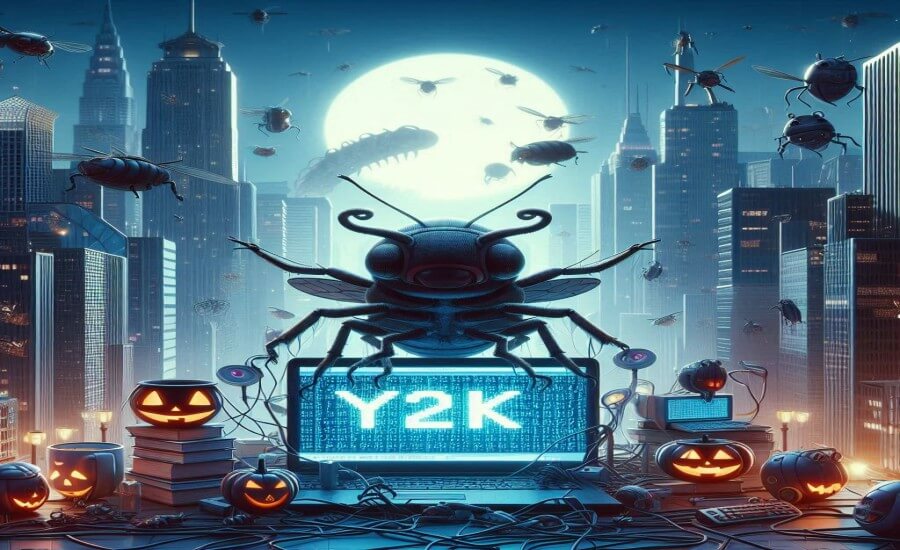Remember that feeling? Mashing buttons randomly in a game, typing a weird command just to see what happens, or clicking aimlessly in a program's 'About' box... and suddenly, something unexpected appears. A hidden message, a secret game, a developer's name flashing on screen. That jolt of surprise, the thrill of uncovering a hidden gem – you've just found a tech Easter egg! Let's embark on a chronological hunt through the history of these delightful digital secrets.
The Genesis Era: Seeds of Secrecy (Pre-1980)
 Long before graphical interfaces or game consoles graced our homes, the seeds of Easter eggs were sown in the collaborative, often playful, culture of early mainframe and minicomputer programmers. These weren't called "Easter eggs" yet, but the spirit was there. Programmers, often working long hours on complex systems, sometimes embedded hidden commands or messages known only to insiders.
Long before graphical interfaces or game consoles graced our homes, the seeds of Easter eggs were sown in the collaborative, often playful, culture of early mainframe and minicomputer programmers. These weren't called "Easter eggs" yet, but the spirit was there. Programmers, often working long hours on complex systems, sometimes embedded hidden commands or messages known only to insiders.
One of the earliest documented examples dates back to the PDP-6/PDP-10 systems around 1967-1968. If a user typed the command make love, the system would cheekily respond not war? before executing the command. Other early examples popped up in games: Moonlander (1973) featured a hidden McDonald's if you flew far enough horizontally, and Colossal Cave Adventure (1976) included secret words like "xyzzy" for teleportation. These early secrets were often in-jokes or simple signatures left by creators in a nascent digital world.
Easter Egg Spotlight: make love (PDP-6/10, circa 1967-68)
- The Egg: Typing make love resulted in the response not war?.
- Significance: Widely considered the earliest known Easter egg in software. It reflected the counter-culture sentiments of the time and the playful nature of early programming communities. It wasn't visually flashy, but it was a hidden, non-standard response triggered by specific input – the core of an Easter egg.
Parallel Developments
The ARPANET, precursor to the internet, was just taking shape. Early video games like Pong were appearing in arcades. The culture was one of exploration, experimentation, and often, a lack of strict corporate oversight on code minutiae.
User Experience Snapshot
Discovering these early secrets was likely accidental or through word-of-mouth within tight-knit university or lab communities. There were no online forums or YouTube tutorials. Finding one felt like being let in on an exclusive inside joke shared directly with the machine's creators.
The Breakthrough Years: The Egg Gets Its Name (1980s)
 The term "Easter egg" burst into the tech lexicon thanks to one programmer's act of defiance. Warren Robinett, developing the Atari 2600 game Adventure (released 1980, egg discovered later), was frustrated by Atari's policy of not crediting game developers – they feared competitors poaching talent. As a hidden signature, Robinett coded a secret, hard-to-reach room displaying the text "Created by Warren Robinett."
The term "Easter egg" burst into the tech lexicon thanks to one programmer's act of defiance. Warren Robinett, developing the Atari 2600 game Adventure (released 1980, egg discovered later), was frustrated by Atari's policy of not crediting game developers – they feared competitors poaching talent. As a hidden signature, Robinett coded a secret, hard-to-reach room displaying the text "Created by Warren Robinett."
When a young player discovered it and wrote to Atari, the company, rather than spending thousands to remove it from manufactured cartridges, embraced it. Director of Software Development Steve Wright compared finding the hidden message to an Easter egg hunt, and the name stuck. This era also gave us perhaps the most famous cheat code used like an Easter egg: the Konami Code.
Easter Egg Spotlight: Adventure's Secret Room (Atari 2600, 1980)
- The Egg: A hidden room containing the programmer's name.
- Trigger: Required finding an invisible "gray dot" pixel and carrying it through a specific path.
- Significance: While not the first hidden secret, it's the one that famously led Atari management to coin the term "Easter egg." It represented a fight for creator recognition.
Easter Egg Spotlight #2: The Konami Code (Debuted in Gradius, NES 1986)
- The Egg: Pressing ↑↑↓↓←→←→BA (often followed by Start or Select).
- Origin: Created by Kazuhisa Hashimoto for the NES port of Gradius because he found the game too difficult to test. It gave the player full power-ups. He forgot to remove it.
- Significance: Popularized by Contra (NES, 1988) where it granted 30 lives, the code became legendary. It has since appeared in countless games (Konami and others), websites, and even hardware, becoming a universal symbol of hidden content. Do you remember frantically inputting it?
Parallel Developments
Home computers (Commodore 64, Apple II) and consoles (NES, Master System) were exploding in popularity. Early graphical user interfaces appeared on Macintosh. Hacker culture and Bulletin Board Systems (BBSes) facilitated the sharing of secrets.
User Experience Snapshot
Finding the Adventure egg was a feat of dedication. Learning the Konami Code felt like unlocking ultimate power, often passed down via playground rumor or gaming magazines. Discovering a hidden credit screen or goofy animation in early Mac OS felt like a personal wink from the developers at Apple.
The Golden Age: Proliferation and Complexity (1990s)
With the rise of powerful PCs, CD-ROMs offering vast storage space, and increasingly complex software, the 1990s became a golden age for Easter eggs. Developers had more room and tools to hide elaborate secrets. Operating systems like Windows 3.1 and Windows 95 contained hidden credits screens, often with animations or photos of the development teams (remember the scrolling names in the volcano?).
Productivity software became a prime hiding spot. Microsoft Office applications famously contained entire hidden games! Excel 97 housed a fully functional flight simulator, while Excel 2000 featured a 3D racing game ("Dev Hunter"). Games like Doom became legendary for their secret levels and hidden references. Easter eggs were moving beyond simple text messages into interactive experiences.
Easter Egg Spotlight: Excel 97 Flight Simulator
- The Egg: A surprisingly detailed flight simulator hidden within Microsoft Excel 97.
- Trigger: A complex sequence involving creating a specific chart, accessing 3D view, typing a code, and using the mouse.
- Significance: Represented the peak of elaborate Easter eggs hidden in serious productivity software. It showcased developer skill and whimsy on a massive platform, becoming one of the most famous eggs of the era.
Discovery Timeline (Conceptual)
- Early 90s: Hidden credits screens (Windows 3.1), simple jokes, cheat codes doubling as eggs (Doom IDDQD/IDKFA).
- Mid-90s: More elaborate animations/presentations (Windows 95 credits).
- Late 90s: Fully interactive hidden games within applications (Excel 97/2000), complex game secrets requiring specific actions.
Why Hide Them?
Beyond creator recognition (still a factor), developers hid eggs for fun, to test their skills, relieve boredom during long development cycles, pay homage to influences (like Doom's Wolfenstein 3D levels), or simply because they could in an era before hyper-strict code reviews and security audits.
User Experience Snapshot
Finding these required dedication or following intricate guides shared online via newsgroups or early websites. The payoff felt huge – discovering a whole game inside a spreadsheet program was mind-blowing! It fostered a sense of community among users actively hunting for these secrets.
The Web & Mobile Revolution: New Playgrounds (2000s - Early 2010s)
 The internet boom and the rise of mobile devices created new canvases for Easter eggs. Google became famously prolific, hiding countless secrets in its search engine. Typing "do a barrel roll" made the results page spin, "askew" tilted the page, "zerg rush" unleashed tiny 'o's to eat the results, and the Konami code might trigger lens flares on Google Images.
The internet boom and the rise of mobile devices created new canvases for Easter eggs. Google became famously prolific, hiding countless secrets in its search engine. Typing "do a barrel roll" made the results page spin, "askew" tilted the page, "zerg rush" unleashed tiny 'o's to eat the results, and the Konami code might trigger lens flares on Google Images.
Web developers hid messages in HTML source code or triggered animations with specific clicks. Mobile operating systems joined in: repeatedly tapping the Android version number in Settings revealed a unique animation or mini-game specific to that OS release (Gingerbread's zombie art, KitKat's dessert tiles, etc.). Early mobile apps and games also carried on the tradition.
Easter Egg Spotlight: Google Search Tricks ("do a barrel roll," etc.)
- The Egg: Various hidden animations, games, or informational quirks triggered by specific search queries.
- Significance: Brought Easter eggs to a massive, mainstream audience in a readily accessible way. They showcased Google's playful corporate culture and technical creativity on its most visible product.
Gained / Lost
- Gained: Wider accessibility, instant gratification (search eggs), platform-specific eggs (Android versions).
- Lost: Some of the deep, game-changing secrets of the past. Web eggs were often simpler visual gags rather than complex hidden features. The need for secrets to work across browsers/devices added constraints.
Unexpected Consequences
While mostly harmless fun, hidden code, even Easter eggs, started raising security eyebrows. Could undocumented features be exploited? This question began to loom larger.
User Experience Snapshot
Finding Google eggs became a fun distraction shared quickly on social media. Discovering the Android version egg felt like an exclusive secret for knowledgeable users. It was less about deep system exploration and more about knowing the right trick or search term.
The Modern Landscape: Security, Subtlety, and Systems (Mid-2010s - Present)
In the modern era, the landscape for Easter eggs has shifted. Increased focus on security and streamlined code means that elaborate, hidden mini-games within major operating systems or productivity suites are rarer. Microsoft, for instance, formally discouraged Easter eggs starting with its Trustworthy Computing initiative in 2002, viewing undocumented code as a potential vulnerability.
However, Easter eggs are far from extinct!
- Hardware/Embedded Systems: Companies like Tesla have embraced them, with cars featuring hidden modes like Rainbow Road visuals, a dancing car show ("Holiday Show"), or even romance modes.
- Web & Apps: They persist, often as subtle animations, hidden menus (Konami code on Discord's 404 page unlocks Snake), or console log messages for developers. Slack's /unicorn command is a simple example.
- Games: Still a stronghold, though often integrated as hidden achievements, obscure lore details, or references rather than game-breaking cheats. Indie games frequently feature them prominently.
- Developer Tools: Browser developer consoles often contain hidden messages or warnings for those poking around.
The spirit lives on, often in more subtle or hardware-integrated ways, and the hunt continues within dedicated communities.
Easter Egg Spotlight: Tesla's Various Vehicle Secrets
- The Egg: Numerous hidden features in Tesla cars, including driving visualizations mimicking Mario Kart's Rainbow Road, a "Holiday Show" light and door sequence, emissions testing mode jokes ("fart mode"), and more.
- Significance: Shows the migration of complex Easter eggs into hardware and integrated software systems, using the car's unique capabilities (screens, motors, lights, speakers) as the playground.
Heritage Impact
Easter eggs cemented a playful aspect of developer culture. They encouraged user exploration and fostered online communities dedicated to discovery. While security concerns have tempered their presence in some areas, their legacy influences user interface design (delightful micro-interactions) and the ongoing desire for developers to leave a personal touch.
Full Circle Reflections
From Warren Robinett wanting credit to Tesla engineers making a car dance, the core impulse remains: a desire to connect with the user beyond the standard functionality, to surprise and delight, and to leave a small, hidden mark of human creativity within the cold logic of the machine. The methods and platforms have evolved, but the hunt for hidden gems continues.
FAQ: Hunting for Hidden Gems
-
What was the very first tech Easter egg?
While Warren Robinett's secret room in Atari's Adventure (1980) popularized the term "Easter egg," earlier examples exist, including a "make love" / "not war?" response on PDP systems (c. 1967-68) and hidden features in games like Moonlander (1973). - Why do developers hide Easter eggs?
Motivations vary: seeking recognition when companies didn't give credit, pure fun and whimsy, relieving boredom, showcasing technical skill, paying homage to influences, communicating directly with dedicated users, or sometimes (though riskily) leaving undocumented backdoors. - Are Easter eggs still common today?
They are less common and elaborate in major operating systems and productivity software due to security concerns and stricter development practices. However, they still thrive in video games (especially indie titles), web applications, hardware/embedded systems (like Tesla cars), and developer tools. - What is the Konami Code?
It's a famous cheat code sequence (Up, Up, Down, Down, Left, Right, Left, Right, B, A) first used in Konami's NES game Gradius (1986) and popularized by Contra (1988). It's become a widely recognized symbol and trigger for Easter eggs across many platforms. - How are Easter eggs typically found?
Through accidental discovery (random clicking/typing), deliberate searching based on rumors or patterns, code decompilation, following online guides and communities dedicated to hunting them, or sometimes hints from the developers themselves.





